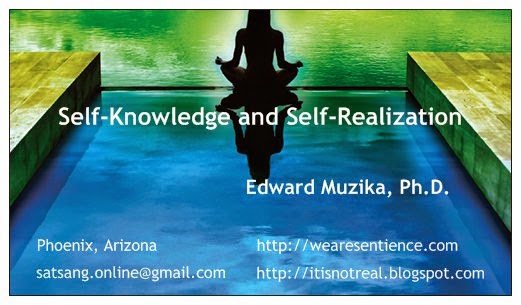Four years ago I began an experiment in teaching
emphasizing introspective exploration of the I Am sense, not with the intent of
transcending it and finding the Absolute Witness, but to explore all levels of
human or embodied Consciousness. This included a special emphasis on three
areas: Love/devotion/and surrender as number 1, exploration of all aspects of
Subtle Body energies, and the bliss arising into the Subtle Body from deeper levels
within Consciousness, and all aspects of human emotionality that emerge through
the introspective process.
Many observers back then were unhappy with my
emphasis on physicality and the Manifest Consciousness as opposed to
Nisargadatta’s emphasis on the Unmanifest Self, the Witness, the Absolute,
Parabrahman.
I responded by showing that in Ramana’s own view,
the awakening he pointed to was attaining the experience of Satchitananda,
existence/knowledge/bliss, by immersion within the 4th state,
Turiya, and then identification with that state as I or Self.
In fact, this is exactly the path Nisargadatta
took before becoming a Jnani emphasizing the Witness or Parabrahman. In his
earliest work, Self-Knowledge and Self-Realization, he speaks in terms of
understanding and experiencing “energies,” then discovering Krishna
Consciousness through Loving introspection and devotion to God and Guru,
finally dwelling in Krishna Consciousness, divine bliss, Satchitananda.
However, by the end of his life all the bliss and energies seem to have departed, or at least he did not talk about them, and condemned all experience, all phenomena, as being unreal, the only reality being the impersonal observer, the Witness, Parabrahman.
However, by the end of his life all the bliss and energies seem to have departed, or at least he did not talk about them, and condemned all experience, all phenomena, as being unreal, the only reality being the impersonal observer, the Witness, Parabrahman.
Robert Adams and Ramana both usually refer to the
experiences of bliss as a stage reached before attaining the Absolute, and
Ramana mixed his own direct experience with Advaidic philosophies and complex
series of Samadhis and purification that made his teachings rather complex and
self-contradictory. Robert on the other
hand, just emphasized being the impersonal witness and in that state,
experienced “peace beyond understanding,” which was also Nisargadatta’s claimed
state.
 |
| Ed with Deeya, Cofounder of Devotional Advaita |
To me, without the wetness of the love, devotion, bliss, and surrender of Turiya, the way to the Absolute can be so dry and barren that depression and loss of motivation to continue can leave one hanging in a barren Void.
Zen avoids the tragedy of Advaita going awry by emphasizing the immediacy of present experience as much as Emptiness and the Void and placing little value on just witnessing once you have discovered the intertwined identity of experiential forms and emptiness.
Unfortunately, Zen has its own dryness because it does not value human emotions, love, devotion, and the experience of bliss, that is, experience of the Manifest Self, the Atman, as having any value except as just another appearance in Consciousness. In fact, some Zen masters emphasize Emptiness more than the objects of Consciousness, such as our perceived bodies, or the dirt under foot, because Emptiness, by being relatively featureless, does not appear to change.
Indeed, Zen Master Sasaki directly told me to my face that there is no love in Zen. One can spend years reading Zen literature and find rarely any mention of love or emotions other than anger, anxiety, and confusion prior to enlightenment. The emphasis of Zen is on the duality of form and emptiness, of life and death, and how they fold into each other.
My way has transformed into a method of loving the
I Am, finding and immersing in it, allowing it to grow into a powerful sense of
energetic presence, along with reading the Nisargadatta Gita and my own Hunting
the I, as meditation manuals. I also emphasize
loving others in the world, which can start as a result of a powerful erotic
love, or even a deep love and bonding with an animal. Along with this I emphasize listening to
sacred Eastern music and chanting which also energizes one’s sense of presence
and can lead to feelings of deep love and of bliss. Then I emphasize coming to Satsang and
feeling the energies and bliss that circulate among us all for the hour
and a half it lasts.
In this way we begin to awaken the Shakti in us in
a far more natural way, less effort-full, and more attractive because of the felt
energies, bliss, and the infusion of our emotional selves as we become more
aware of feelings long repressed or dried up.
One also learns the key lesson, that just as emptiness underlies all forms, bliss underlies the emotional body level, and, when strong emotions arise, if we can accept them and allow them to permeate our hearts letting them be us for a while, we then come out on the other side to find a deep river of bliss. One gets fastest to that bliss through the emotions of love and grief or loss; both emotions arise out of a very deep part of who we are as opposed to many other emotions that are more situational and less relational in origin.
The intent is to become so alive to our human existence, to love it and all that arises during immersion into the I Am sensation, to finally a realization of the divine in us as the Manifest Self, Turiya, or the Atman.
Later, if you so choose, you can go further to the realization of the Absolute Witness, the Unmanifest Self, but even then you will still have access to an alive Manifest Self for balance and wetness.

so good. so complete. this is THE teaching. this is a feast of Truth, on multiple-levels. this makes the one dimensional spirituality of the marketplace look like kindergarten, like a joke. THIS is the embodiment.
ReplyDeleteBeautiful
ReplyDeleteLisha